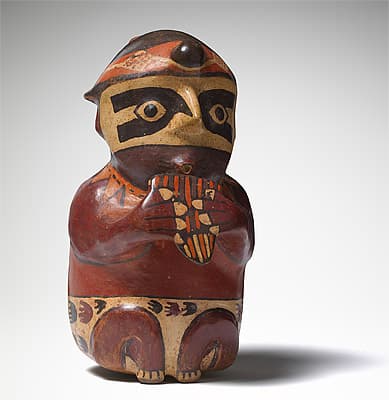
NAZCA culture South coast 100 – 700 AD
Vessel in the form of a musician 100-700 AD ceramic21.6 (h) x 12.0 (w) x 15.8 (d) cm National Gallery of Australia, Canberra NGA 1984.3047 Purchased 1984
Sometimes ordinary people were buried with figures and implements showing their occupations, such as the musician playing a panpipe. Music was important for ceremonies, as excavated bells, rattles and pipes demonstrate. Throughout the Andes, ceramic single- and double-chambered vessels called silbadoras also made sounds. A hollow sphere of clay with a small hole was secured inside the vessel so that when you blow into the spout, air passes across the hole. Liquid half fills double-chambered bottles, which whistle when the vessels are tilted.
Sometimes ordinary people were buried with figures and implements showing their occupations, such as the musician playing a panpipe. Music was important for ceremonies, as excavated bells, rattles and pipes demonstrate. Throughout the Andes, ceramic single- and double-chambered vessels called silbadoras also made sounds. A hollow sphere of clay with a small hole was secured inside the vessel so that when you blow into the spout, air passes across the hole. Liquid half fills double-chambered bottles, which whistle when the vessels are tilted.
Sometimes ordinary people were buried with figures and implements showing their occupations, such as the musician playing a panpipe. Music was important for ceremonies, as excavated bells, rattles and pipes demonstrate. Throughout the Andes, ceramic single- and double-chambered vessels called silbadoras also made sounds. A hollow sphere of clay with a small hole was secured inside the vessel so that when you blow into the spout, air passes across the hole. Liquid half fills double-chambered bottles, which whistle when the vessels are tilted.

